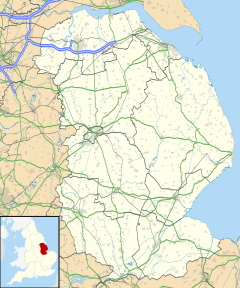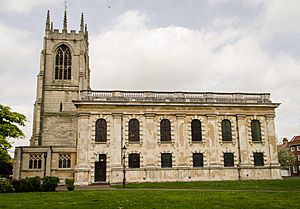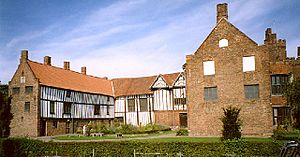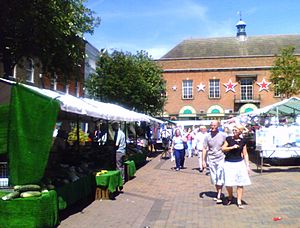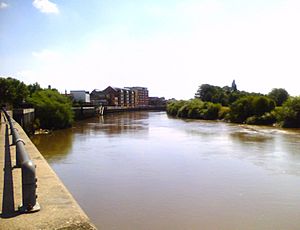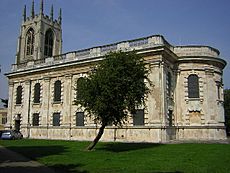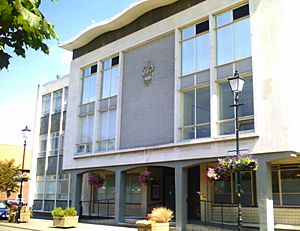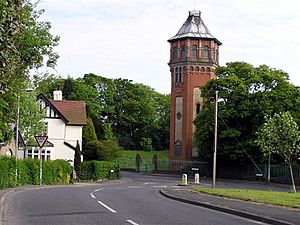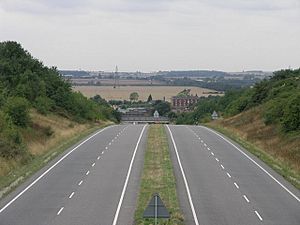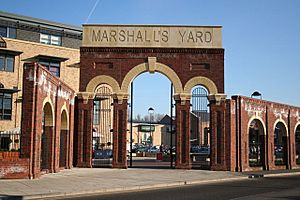Gainsborough, Lincolnshire facts for kids
Quick facts for kids Gainsborough |
|
|---|---|
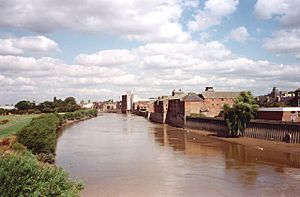 Gainsborough waterfront and the River Trent |
|
| Population | 22,841 (2017 estimate) |
| OS grid reference | SK815901 |
| • London | 135 mi (217 km) S |
| District |
|
| Shire county | |
| Region | |
| Country | England |
| Sovereign state | United Kingdom |
| Post town | GAINSBOROUGH |
| Postcode district | DN21 |
| Dialling code | 01427 |
| Police | Lincolnshire |
| Fire | Lincolnshire |
| Ambulance | East Midlands |
| EU Parliament | East Midlands |
| UK Parliament |
|
Gainsborough is a market town and inland port in the West Lindsey district of Lincolnshire, England. The town population was 20,842 at the 2011 census, and estimated at 23,243 in 2019. It lies on the east bank of the River Trent, 18 miles (29 km) north-west of Lincoln, 16 miles (26 km) south-west of Scunthorpe, 20 miles south-east of Doncaster and 39 miles (63 km) east of Sheffield. It is England's furthest inland port at over 55 miles (90 km) from the North Sea.
Contents
History
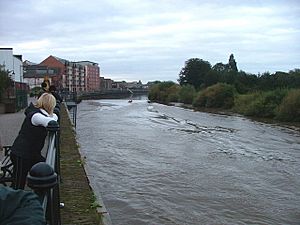
King Alfred, Sweyn Forkbeard and Canute the Great
Gainsborough was one of the capital cities of Mercia during the Anglo-Saxon period, which had preceded Danish rule. It is understandable that the Viking kings would have been drawn to it as an administrative centre, being close to the Danish stronghold at Torksey.
In 868 King Alfred married Ealswitha, daughter of Aethelred Mucill, chief of the Gaini, whence the town gets its name.
Historically, Gainsborough is the "capital that never was". Towards the end of July 1013, the Dane Sweyn Forkbeard, together with his son Canute, arrived in Gainsborough with an army of conquest. Sweyn defeated the Anglo-Saxon opposition and King Ethelred fled the country. Sweyn was declared King of England, and he returned to Gainsborough. Sweyn and Canute took up high office at the Gainsborough Castle (on the site of the present-day Old Hall), while his army occupied the camp at Thonock (today known as Castle Hills). But King Sweyn was killed five weeks later when he was thrown from his horse in Gainsborough. His son Canute established a base elsewhere.
King Canute may have performed his unsuccessful attempt to turn the tide back in the River Trent at Gainsborough. Historians believe he may have been demonstrating on the aegir, a tidal bore. He and his supporters may have known Gainsborough was the furthest reach of the aegir, and ideal for his demonstration. However the story was only written down a century later by Henry of Huntingdon, who gives no location, and may have been a myth or a fable.
Medieval Gainsborough
The Domesday Book (1087) records that Gainsborough was exclusively a community of farmers, villeins and sokemen, tenants of Geoffrey de Guerche. The population was only about 80 people, of which about 70% were of Scandinavian descent.
The Lindsey Survey of 1115-18 records that Gainsborough was then held by Nele d’Aubigny (known as Nigel the Black). He was the forebear of the Mowbray family, and the Mowbray interest in Gainsborough continued until at least the end of the 14th Century.
A weekly market was granted by King John in 1204.
Gainsborough Old Hall
Thomas Burgh acquired the manor of Gainsborough in 1455. He built Gainsborough Old Hall between 1460 and 1480, a large, 15th-century, timber-framed medieval strong house, and one of the best-preserved manor houses in Britain. It boasts a magnificent Great Hall and strong brick tower. King Richard III in 1483 and King Henry VIII in 1541 both stayed at the Old Hall. The manor was sold to the Hickman family in 1596.
English Civil War
The town was garrisoned for the King in January 1643 and began co-operating with the garrison at Newark in raiding the surrounding countryside and harassing the Parliamentarians there. With the Great North Road blocked to Parliamentarian traffic, Gainsborough became significant as part of a route around Newark by way of Lincoln and the line of the modern A15 road. It was in the Royalists' interests to obstruct this, which gave rise to the battles of Gainsborough and Winceby. Parliament captured Gainsborough in the battle on 20 July but was immediately besieged by a large Royalist army and forced to surrender after three days.
Parliament captured Gainsborough again on 18 December 1643, but was forced to withdraw in March 1644, razing the town's defences to prevent their use by the enemy. The Earl of Manchester’s army passed through Gainsborough in May 1644 on its way to York and the Battle of Marston Moor.
After the Civil War ended in 1645, several people in Gainsborough were fined for their Royalist sympathies, including Sir Willoughby Hickman at the Old Hall, who had been created the first Baron Gainsborough by Charles I in 1643.
Churches
The first recorded evidence of a church at Gainsborough is in 1180, when the rectory there was granted by Roger de Talebu to the great Preceptory of the Knights Templar in Lindsey, at Willoughton. In 1547, following the Protestant Reformation, the parish of Gainsborough came under the jurisdiction of the Bishop of Lincoln for the first time.
The medieval Church of All Saints fell into disrepair after the Civil War, and in 1736 it was demolished to make way for a new church. The new Parish Church was completed in 1748 with a mix of perpendicular Gothic and Classical Revival styles. All that remains of the Medieval church is the west tower, 90 feet high, and housing eight bells. A monument to Richard Rollett, master sailmaker on Captain James Cook's second voyage in 1824, is located in the porch.
The town's increasing population in the 19th Century required the building of a second church in the south of the town, and Holy Trinity Church opened in 1843. This was followed by St John the Divine Church on Ashcroft Road in 1882, and St George's Church on Heapham Road in the 1950s. Holy Trinity closed in 1971 (and is now the Trinity Arts Centre), and St John the Divine closed in 2002.
Non-conformism flourished in Gainsborough. Some of the Mayflower Pilgrims worshipped in secret at the Old Hall before sailing for Holland to find religious freedom in 1609. The John Robinson Memorial Church in Church Street was dedicated in 1897; the cornerstone had been laid by Thomas F. Bayard, U.S. Ambassador. Now the United Reformed Church it was named in honour of John Robinson (1576 – 1625), the pastor of the "Pilgrim Fathers" before they left on the Mayflower.
John Wesley, the founder of Methodism, preached in Gainsborough several times between 1759 and 1790. The town's first Methodist chapel opened in Church Lane in 1788, moving to a new site in North Street in 1804 (and rebuilt there as St Stephen's in 1966). The Primitive Methodists became established in the town in 1819, with chapels in Spring Gardens (1838), Trinity Street (1877) and Ropery Road (1910). St Thomas' Church in Cross Street caters for the town's Roman Catholics.
Second World War
Gainsborough suffered its only large-scale air raid of the war on the night of 10 May 1941. High explosive bombs and incendiaries were dropped but many of them fell harmlessly on the surrounding countryside. There was only minor damage in the town, and no casualties.
On the night of 28–29 April 1942 a single Dornier 217 dropped a stick of bombs on the town centre, causing extensive damage and the loss of seven lives.
On 31 December 1942, a RCAF Bristol Beaufighter aircraft on a training exercise crashed on Noel Street, killing both airmen and a three-year-old girl.
On 22 May 1944 a RAF Spitfire fighter, in a training exercise, accidentally collided with a Wellington bomber and crashed into a Sheffield-bound goods train as it was passing over the railway bridge on Lea Road. The pilot was the only casualty.
In the early hours of 5 March 1945 a single Junkers 88 fighter/bomber made a low level attack over the town, dropping anti-personnel bombs on Church Street and the surrounding residential area. Three people lost their lives and 50 houses were damaged.
New town
There was a proposal to develop Gainsborough as a new town linked to Sheffield, but the plan was not pursued. New housing was instead built to the south east of Sheffield.
Governance
The town was formerly, before 1974, in the county of Lindsey in the Gainsborough Urban District Council. West Lindsey District Council was formed from five former councils.
Gainsborough Town Council was established in 1992, and in the same year Gainsborough's first Mayor was appointed.
Sir Edward Leigh has been Gainsborough's MP since 1983.
Oil
In July 1958, BP discovered oil at Corringham, then at Gainsborough in January 1959.
Geography
The town is at the meeting point of the east-west A631 (which crosses the Trent on Trent Bridge at the only point between the M180 and the A57), the A156 (from the south to Torksey) and A159 (from Scunthorpe). Thorndike Way, Gainsborough's dual carriageway, intended to connect with the A15 at Caenby Corner, only extends eastward to the town boundary, and is named after the actress Dame Sybil Thorndike (born in the town in 1885). The former A631 through the town is now the B1433.
The civil parish extends southwards across much rural land to Lea. The boundary passes to the south of Warren Wood, north of Lea Wood Farm, and passes along the northern edge of Lea Wood. Passing northwards through Bass Wood, it meets Corringham, the main settlement to the east of Gainsborough. The boundary crosses Thorndike Way (A631) and briefly follows the B1433. At Belt Farm it meets Thonock, then follows The Belt Road, to the south of Gainsborough Golf Club (also nearby are Thonock Park and Karston Lakes golf courses), then down Thonock Hill - the edge of the Trent Valley.
George Eliot and The Mill on the Floss
Many scholars believe Gainsborough to be the basis for the fictional town of St Ogg's in George Eliot's The Mill on the Floss (1860). The novelist visited Gainsborough in 1859, staying in the house of a shipbuilder on Bridge Street (which survives today as the United Services Club). The stone bridge and the nearby willow tree are mentioned, and the Old Hall is described in detail. Thomas Miller’s Our Old Town published two years before, included the true story of a miller who loses a lawsuit after assaulting his adversary, and George Eliot used a similar story plot in The Mill on the Floss as the basis of the Tuliver/Wakem feud. It’s also possible that she witnessed the aegir on the Trent, which inspired the flood in her story’s climax.
Landmarks
Beside Riverside Walk are the Whitton's Mill flats, which won the Royal Town Planning Institute award for the East Midlands. Marshall's Yard also received an award for regeneration.
West Lindsey District Council used to have their main offices at the Guildhall on Lord Street, but in January 2008, they moved to a new £4.3m building in Marshall's Yard. The old building was to have been converted into a hotel but some residents believe it is a financial millstone for the people of West Lindsey.
Silver Street is home to many of Gainsborough's shops. Elswitha Hall is the birthplace of Halford John Mackinder, founder of the Geographical Association.
A large water tower stands on Heapham Road, built in 1897 to commemorate the Diamond Jubilee of Queen Victoria.
Transport
Railway
- Further information: Gainsborough Lea Road railway station and Gainsborough Central railway station
The town has two railway stations on different routes. The main station is Gainsborough Lea Road in Lea Road (A156) in the south of the town, serving the Sheffield-Lincoln and Doncaster-Lincoln lines with mainly hourly services to Lincoln, Sheffield and Doncaster. Sheffield services generally call at Retford, Worksop and Sheffield only, then continue towards Leeds. The other station is Gainsborough Central near the town centre. It serves the Brigg branch line and is the terminus of an hourly service to and from Sheffield on Mondays to Saturdays, calling at all stations. On Saturdays there are three services to Cleethorpes via Brigg and Grimsby Town.
Where the railway crosses the Trent, the four lines come together at two junctions on either side of the river. The lines from Lincoln and Cleethorpes meet at East Trent Junction, east of the river. Those from Sheffield and Doncaster meet at West Trent Junction on the opposite side in Nottinghamshire.
West Burton Power Station is three miles (5 km) to the south-west of the town, next to the Sheffield-Lincoln Line.
Buses
The town bus station in Hickmen Street has frequent services on Monday to Saturday, but no Sunday services. Most town routes are served by Stagecoach. Two local services connect the uphill area of the town and Morton to the town centre, one running clockwise, the other anti-clockwise. The town has a connection hub with hourly services to Lincoln, Scunthorpe and Retford and a service to Doncaster every two hours. These serve several villages along the route. Other bus services run during school terms.
Rivers
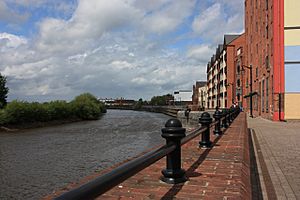
Gainsborough is claimed as the British port furthest inland. It has had a long history of river shipping trade.
There is still one wharf, but ships no longer navigate this far up river. Commercial shipping remains further down the river at Gunness Wharf, Grove Wharf and Flixborough Wharf, which has direct rail links. This leads to some to argue that Goole, (23.7 miles (38.1 km) to the north of the town, is now the most inland port in the UK.
At the A631 Trent Bridge, there was a ferry before 1787, a distance of 235 feet. The bridge was completed for £12,000 in the spring of 1791, but it meant that taller river traffic of the day could no longer go further upstream. Originally a toll bridge, it was bought by the Ministry of Transport, Lindsey County Council, Gainsborough Urban District and Nottinghamshire County Council for £130,000 in 1927 and declared toll-free on 31 March 1932.
Economy
Boiler-maker and ironworks
Gainsborough has a long history of industry. It was the manufacturing base of Marshall, Sons & Co., a boiler-maker founded by William Marshall in 1848, who died in 1861 and was buried in the cemetery in Ropery Road. His business became one of the joint-stock companies run by his sons James and Henry. It occupied the 16-acre Britannia Ironworks, the biggest in Europe when built. Marshall's Works' steam engines were sold worldwide until it closed in the 1980s. The site is now split among various companies. Tesco in Beaumont Street and Dransfield's occupy about nine acres; the remainder is held by local companies.
Supermarkets
Tesco, on the corner of Trinity Street and Colville Terrace, demolished much of the works to create its store some twenty years ago. It had intended to replace their current store with a 100,000 sq ft (9,300 m2) Tesco Extra store on stilts, with parking beneath, but these plans were scrapped. Dransfield remodelled about nine acres (36,000 sq. m) of the site to include a shopping area and a new heritage museum. The site Marshall's Yard opened during Easter 2007, with additional shops opening after that.
There is a Morrisons branch in Heapham Road South, and Co-ops in the Lindsey Centre, at Morton by Gainsborough and on the site of the Jack and Jill pub by St Georges Community Hall.
Packaging
Another area of Gainsborough industry is Rose Brothers, named after William German Rose and Walter Rose, the co-founders. In 1893 William Rose invented the world's first packaging machine. Two years later it bought the Trentside Works site and started to expand into many other areas, producing items such as starch, razor blades and sweets such as Cadbury's chocolates, its name appearing on the Roses selection. The firm produced seaside rock-making machines, cigarette-making machines and bread-slicing and wrapping machines. When it closed, A. M. P. Rose bought the confectionery packaging side.
By the east bank of the Trent near the railway bridge is a large mill owned by Kerry Ingredients (headquartered in Tralee).
Wigs, jokes and exhausts
Gainsborough is the home of two of the largest importers of jokes and novelties into the UK: Smiffy's (formerly known as RH Smith & Sons, founded in 1894), and Pam's of Gainsborough, a smaller firm founded in 1986. Smiffy's were the only wigmaker left in the UK until December 2008, when bulk production moved to the Far East and over 35 jobs were lost. The firm has set its future goals on a more mature fancy dress and party market.
Another local business is Eminox, founded in 1978. It started by building replacement exhausts for the local bus company, then expanded into manufacturing large stainless steel exhaust systems for buses and commercial vehicles. It also builds low-emission catalytic systems for the London low emission zone.
Sport
The town is home to the semi-professional football club Gainsborough Trinity F.C., which plays in the Northern Premier League, the seventh level of English football. For a brief spell in the early 20th century, the club was professional and a member of the Football League.
Gainsborough Rugby Club (the All Blacks) has played Rugby Union in the town since 1924.
The town is home to the Gainsborough & Morton Striders Athletic Club, who in 2013 were awarded England Athletics' Run England National Group of the Year. The club was founded in July 1983.
There are several cycling clubs, including Trent Valley Road Club, Viking Velo and Gainsborough Aegir Cycling Club.
Education
Unlike most of the UK, Lincolnshire retains a tripartite system, with secondary education for many pupils decided by voluntary examination at eleven. The town has one of the top state schools in the country, Queen Elizabeth's High School (selective state grammar school from 11 to 18 featuring a sixth form) in Morton Terrace (A159).
QEHS students earn outstanding GCSE and A-Level results and the school is over-subscribed. The town has several primary schools.
There are links beyond the town to the John Leggott Sixth Form College in Scunthorpe, North Lindsey College, and Lincoln College, which has a branch at Gainsborough College in Acland Street, focusing on vocational education.

Notable people
In birth order:
- Sweyn Forkbeard (died 1014), King of Denmark and England, died in Gainsborough.
- Simon Patrick (1626–1707), theologian and Bishop of Chichester
- Willoughby Bertie, 4th Earl of Abingdon (1740–1799), peer and music patron
- Thomas Mozley (1806–1893), clergyman and writer
- Thomas Miller (1807–1874), author and poet
- James Bowling Mozley (1813–1878), theologian
- John Collingham Moore (1829–1880), portrait painter
- Sir Halford Mackinder (1861–1947), geographer and explorer
- George Cuckson (1878–1915), footballer
- Dame Sybil Thorndike (1882–1976), actress
- Frank Airey (born 1887), footballer with Gainsborough Trinity
- Rex Woods (1903–1987), artist and illustrator
- Bill Podmore (1931–1994), TV producer, Coronation Street
- Mervyn Winfield (1933–2014), Nottinghamshire cricketer
- John Alderton (born 1940), actor, Upstairs Downstairs, Please Sir!
- John Hargreaves (born 1944), England cricketer
- Andy Dalby (born 1948), guitarist with Kingdom Come and Camel
- Julia Deakin (born 1952), actress
- Steve Housham (born 1976), footballer and manager
- Chris Mosdell (living), lyricist with Yellow Magic Orchestra, Eric Clapton and Michael Jackson
See also
 In Spanish: Gainsborough (Lincolnshire) para niños
In Spanish: Gainsborough (Lincolnshire) para niños


